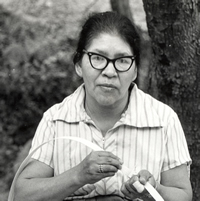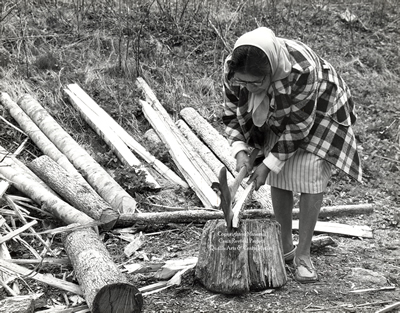People: Emma Taylor
Emma Squirrel Taylor (1920-2002) was a master Cherokee basket weaver whose specialty was white oak baskets. After learning how to make baskets in 1927, she produced them for more than half a century. In 1952 she joined Qualla Arts and Craft Mutual, a Cherokee artisan cooperative. In the 1970s and 1980s, she exhibited her work at Qualla Arts and Craft Mutual and at the Folk Art Center on the Blue Ridge Parkway. In 1989, the North Carolina Arts Council presented her with a North Carolina Folk Heritage Award. Emma Taylor’s work earned her recognition well beyond western North Carolina’s Qualla Boundary. An article about her work appeared in the New York Times and she traveled to Japan to demonstrate Cherokee basket weaving to the World Craft Council.
Born July 4, 1920, a young Emma Squirrel learned to make white oak baskets by watching her mother, Lydia Ann Squirrel. Her experience demonstrates how tradition passed from generation-to-generation by watching, rather than by direct instruction. She recalled,
“I was about seven years old when I learned how to make baskets from watching my mother. Whenever Mother would sit out there in the yard, she’d be taking out splints. I’d gather up all those short ones, and I’d try to make a basket. I couldn’t make them at the beginning. My mother, she didn’t really teach me how to make the basket; I learned how to make a basket just by seeing.” 1
Emma Squirrel grew up on Coopers Creek, in the Birdtown community in the mountains of western North Carolina. She attended Birdtown Day School and Cherokee High School. While attending high school, she met Lottie Queen Stamper, a master basket weaver and teacher, who taught her how to work rivercane.
“After I went to school, then I quit making baskets. I wasn’t there to watch Mother make baskets. I was in boarding school. Along the way they brought basketweaving in, teaching it in the school, and I learned how to make a cane basket.” 2
Emma Taylor’s comment—that she quit making baskets when she first went to school—demonstrates the social tension between traditional methods of learning and formal means of education that have been part of Cherokee life.
In 1942, Emma Squirrel left school and married Timpson Taylor and began making baskets again. The family lived in the Birdtown community on the Qualla Boundary, lands owned by the Eastern Band of the Cherokee Indians. Taylor sold her baskets to help with the costs of raising the couple’s eight children and taught the craft to all five of her daughters. Three of them—Louise Taylor Goings, Faye Junaluska, and Katrina Taylor—followed their grandmother and mother to become the next generation of basket weavers.
In Arts and Crafts of the Cherokee, Professor Rodney L. Leftwich wrote that, historically, “The user of an implement or utensil was the maker of it.” Emma Taylor’s own comment confirms his statement. “The person that makes the basket, she knows what kind to get,” she said describing the start of the process. While others sometimes helped, a basket maker knew best what she needed and usually went in search of her own trees to cut. That search begins outdoors, binding the craft to nature both in process and material. This work takes physical strength; Taylor used an ax to cut and prepare white oak. She explained how a basket maker begins, by cutting a “chip” from a living tree to assess its suitability as a resource. Aware of the impact of her basket production on the natural world, she remarked, “Sometimes we make a mistake…and later the tree dies.” In an interview published by Qualla Arts and Crafts as part of its Promotional Exhibits series of 1969-1985, author Mollie Blankenship noted that Taylor could still “maneuver a double-bitted ax with the skill of a man.” At the time she was 55 years old. 3
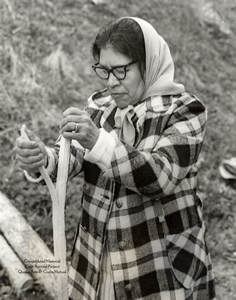 The material from one tree is enough to make four baskets |
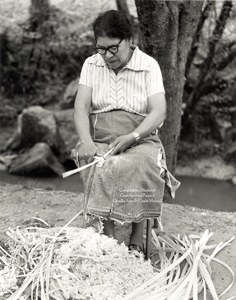 It takes a week to prepare enough splits for eight baskets |
It takes two trees to produce eight baskets. For a white oak basket maker, a day in the woods may yield three good trees. With that, it still takes an additional week to prepare enough splits for eight baskets and another week to weave them. Taylor explained how the economics of making and selling baskets was tied to an adequate supply of natural resources. Indeed, the craft itself is often dictated by what is available as a resource material. In 1977, Taylor noted that cane was beginning to be scarce and remarked, “I’d make cane baskets if I could get the cane.” She explained the plight of diminishing resources, “We used to have plenty of cane right by the river, but they’ve been building so many roads by the river they’ve just destroyed our river. We have to go clear to Tennessee to get our cane.” Eva Wolfe, another Cherokee basket weaver of the same generation, confirmed her experience. Wolfe regularly drove 80 miles to Hayesville, North Carolina to gather cane. 4 Changing circumstances and social conditions have always played a part in Cherokee basketry. Its past, present, and future depend on the availability of natural resources and a market to sell them.
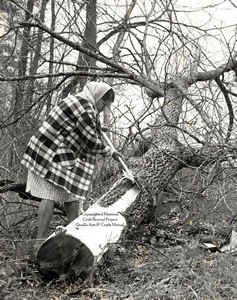 The bark from a walnut tree is used to make dye |
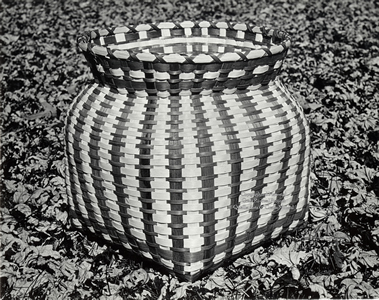 A finished white oak basket with splits dyed with walnut |
Before the tourist trade became a viable sales option for Cherokee craftspeople, most crafts—including baskets—were valued primarily for their function. Qualities like sturdiness, comfort, and serviceability were hallmarks of late 19th and early 20th century baskets. Lydia Ann Squirrel, Emma Taylor’s mother, made purely functional baskets to sell and trade. Taylor recalled how a changing social situation changed the way they sold their baskets. Speaking of her mother’s baskets, she said, “She’d take and trade them for potatoes….By the time I started out, there was shops to sell them in.” After tourists began to purchase baskets in the 1930s and 1940s, how a basket looked figured into its sales appeal. “I don’t remember anything back then but market baskets—big baskets with the handles on them.” Taylor’s mother did not dye her white oak splits; instead she made purely serviceable baskets in a natural color without designs. Taylor, like most basket weavers of her generation, dyed her materials and wove patterns into her baskets. 5
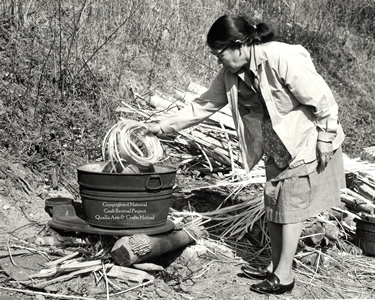 Taylor dyeing white oak splits using native plants |
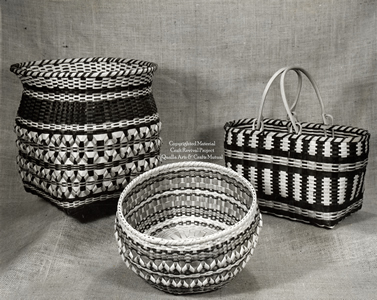 A variety of patterned baskets by Emma Taylor |
Emma Taylor has promoted basket making throughout the region and brought her work to the world as well. Locally, she demonstrated at the Oconaluftee Indian Village and won numerous blue ribbons at the annual Cherokee Indian Fair. In the spring of 1975, her work was shown in a one-person exhibition at Qualla Arts and Crafts Mutual. Recognizing the hard work and discipline that went into her craft, Emma Taylor’s perspective on the future of Cherokee basket making was dim. “I think all our basketwork will just go away because these young children won’t try to learn.” 6
In 1977 the New York Times ran an article about Taylor to accompany a traveling exhibition of her work. The following year, she demonstrated at the 8th Annual World Craft Council meeting in Kyoto, Japan, the only Native American of any tribe to do so. In 1983 she exhibited her work at the Folk Art Center on the Blue Ridge Parkway, an exhibit sponsored by the Southern Highland Handicraft Guild, today’s Southern Highland Craft Guild. In 1987 the North Carolina Arts Council sponsored an exhibit of her baskets at Qualla Arts and Crafts Mutual, and in 1989, she was awarded a North Carolina Folk Heritage Award. She was also featured in the 1994 video documentary, Cherokee Artists: The Basket Weavers.
Anna Fariello
Excerpted from Cherokee Basketry: From the Hands of our Elders,
Published by The History Press, 2009
1.Mollie Blankenship and Stephen Richmond, Contemporary Artists and Craftsmen of the Eastern Band of Cherokee Indians: Promotional Exhibits, 1969-1985 (Cherokee, NC: Qualla Arts and Crafts Mutual, Inc, 1987) 57-59.
2. Blankenship, 57-59.
3. Rodney L. Leftwich, Arts and Crafts of the Cherokee (Cherokee: Cherokee Publications, 1970) 15; David Gaynes, Artisans/Appalachia/USA (Boone, NC: App Consortium Press, 1977) n.p.; Blankenship, 57-59.
4. Blankenship, 57-59; Gaynes, n.p.; Mollie Blankenship, “Eva Wolfe: Traditional Basketweaver,” North Carolina Folklore Journal 35, no. 2 (summer-fall 1988) 95.
5. Gaynes, n.p.; Barbara Delatiner, “Basket-Making in the Cherokee Way,” The New York Times, Dec. 18, 1977.
6. Blankenship, 57-59.

